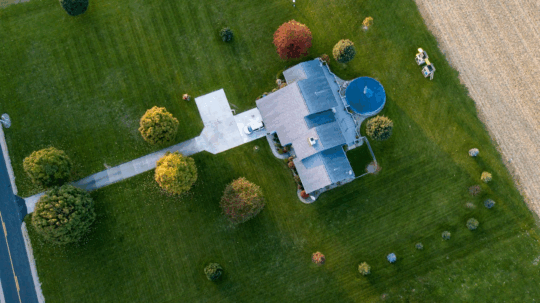
Lawn care is starting to look a little different nowadays. Instead of relying on constant watering, pricey fertilizers, and weekend marathons of yard work, more homeowners are shifting toward practical, eco-friendly habits that cut costs without compromising the look of their lawns. This new approach is about working smarter with what nature already provides, that is, understanding soil, timing, and resource use to create a yard that thrives without draining time or money.
What’s driving this change is awareness. People are noticing how minor adjustments in watering, trimming, and fertilizing can drastically lower bills while keeping grass healthier for longer. With a few mindful habits, lawn care becomes less of a chore and more of a balanced system that quietly pays off over time.
Checking Water Usage Patterns
The health of a lawn depends as much on how it’s watered as on how often. Regularly observing water usage helps identify spots that dry out too fast or stay soggy longer than others. Simple awareness of where and when water is being used can reveal issues that affect both the lawn’s health and the water bill.
A big part of this process involves sprinkler leak detection. Small leaks often go unnoticed but can waste gallons of water each week. Spotting and fixing them on time helps keep irrigation efficient, prevents pooling, and stops hidden waste before it adds up.
Mulching Clippings for Natural Nourishment
Bagging grass clippings after mowing might seem tidy, but it removes one of the lawn’s best natural resources. Mulching leaves those clippings on the ground to decompose and feed the soil, replenishing it with nitrogen and other essential nutrients. This process enriches the lawn from within, reducing the need for commercial fertilizers and keeping growth consistent.
Moreover, mulching helps the soil retain moisture and maintain a balanced temperature. The thin layer of organic matter shields the surface from harsh sunlight, allowing roots to stay hydrated and active. It’s a low-effort, zero-cost way to keep lawns strong while minimizing the need for additives.
Using Drought-Tolerant Grass Varieties
Choosing the right type of grass can completely change how sustainable a lawn becomes. Drought-tolerant varieties adapt easily to heat and dry conditions, needing far less water to stay green. They grow deeper roots that can access moisture below the surface, naturally building resilience without constant care. This way, you get to maintain a healthy look even during dry seasons, cutting down the need for emergency watering or expensive treatments.

Apart from saving water, drought-tolerant grass reduces the overall effort required throughout the year. It grows at a slower pace, meaning fewer mowing sessions and less energy use.
Aerating Soil for Root Health
Healthy roots need room to breathe, and compacted soil can quietly choke that space over time. Aerating breaks up dense patches, allowing water, oxygen, and nutrients to travel deeper into the soil. This simple process improves growth, keeps grass vibrant, and minimizes patchiness.
Regular aeration also prevents surface runoff and encourages even absorption during watering. That means less water waste and stronger roots that can handle dry spells more easily. When done consistently, this habit turns a lawn into a self-sustaining system, one where each watering counts and every root stays supported.
Balancing pH Levels
Soil balance is what decides whether a lawn flourishes or struggles. Testing pH levels helps determine how well nutrients are being absorbed by the grass. When the soil becomes too acidic or alkaline, even the best fertilizers lose effectiveness. Regular testing keeps that balance in check.
Today’s affordable home kits make this process quick and uncomplicated. With just a few small adjustments based on results, homeowners can fine-tune soil conditions to create the ideal environment for growth. The outcome is stronger roots, more even color, and a significant reduction in wasted products.
Planning Seasonal Lawn Maintenance Ahead of Time
Planning seasonal tasks beforehand, like aeration, fertilization, and irrigation adjustments, creates a structure that keeps the lawn consistent year-round. What’s good is that this prevents those last-minute fixes that tend to cost more and often do less. A simple checklist for each season keeps the process easy to follow and builds good habits over time.
Doing the right task at the right time maximizes results without extra effort. When lawn care is scheduled around natural growth cycles and local weather, grass stays healthier with less input.
Reusing Rainwater for Irrigation
Rainwater is one of the most valuable and underused tools in home lawn care. Collecting and reusing it for irrigation cuts down on water bills while giving the lawn a natural boost. Unlike standard tap water, rainwater doesn’t contain added chemicals such as chlorine or fluoride that can alter soil balance over time. It naturally carries small amounts of beneficial minerals that help plants grow at a steady, gentle pace.
Setting up rain barrels or small collection systems takes little effort and pays off quickly. Eventually, the savings build while the lawn benefits from a more natural watering source. Reusing rainwater turns an ordinary weather event into a long-term resource.
Composting Yard Waste for Reuse
Every lawn produces a steady stream of organic material, consisting of leaves, small branches, and clippings. Composting turns that waste into nutrient-rich material that feeds the soil and reduces reliance on store-bought products. It creates a closed loop where the lawn continuously replenishes itself. Compost adds texture, improves soil drainage, and strengthens root systems naturally.
Composting helps build a more balanced soil ecosystem. Earthworms, beneficial bacteria, and fungi thrive, creating a healthier environment for grass growth. This method cuts costs and reduces the environmental footprint of regular maintenance. What was once waste becomes an ongoing supply of free nourishment, supporting both the lawn and the wallet with minimal effort.
Installing Smart Irrigation Controllers
Smart irrigation controllers automatically adapt watering patterns using current weather conditions, sunlight levels, and soil moisture readings. This technology helps avoid overwatering, saves water, and keeps plant growth steady and healthy.
The cost savings are noticeable after just a few months. With automatic adjustments during rainy or cooler periods, water waste drops dramatically. Such systems also provide data that helps homeowners understand their lawn’s specific needs over time.
Timing Fertilization Around Growth Cycles
Timing applications around active growth phases helps the grass absorb nutrients efficiently, preventing waste and reducing runoff. When fertilizer matches the lawn’s natural rhythm, less product is needed, and results last longer. This way, you can keep the lawn nourished without overloading the soil or budget.
Observing the grass’s seasonal patterns makes timing easier. Cool-season grasses, for example, thrive with early spring and fall feedings, while warm-season types respond better to mid-summer care. Adjusting fertilization to fit these patterns turns maintenance into a more precise and rewarding process.
When water use, soil health, and timing come together, the result is a lawn that looks good because it’s well cared for, not overworked. The best part? Each of these habits builds on the other, creating a routine that quietly protects both the grass and the wallet.


















